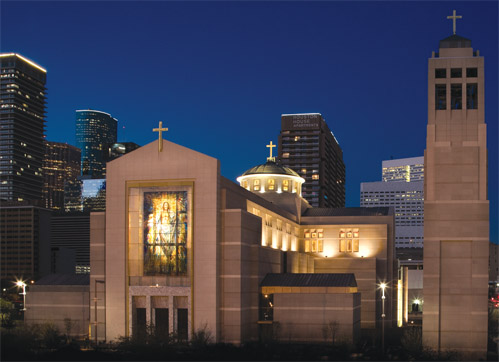I hope to see many readers in Houston, Texas, for a chant practicum, October 21-23, 2010, featuring the instruction of Scott Turkington, William Mahrt, Arlene Oost-Zinner, and Fr. Robert Pasley. This will be an unusual event, with groups divided by voice and level of advancement (no try outs; you can choose which is best for you). It will be held at the Cathedral of the Sacred Heart. Tuition is $165 for all sessions and materials. More information here.
Bartlett’s Setting of the Gloria in English
Adam Bartlett of the Chant Cafe has composed a setting of the Gloria in English. I’m personally crazy for this. It is beautiful, bright, and very intuitive. I can easily imagine that this could become the standard setting for any parish. It is also free for you to use and copy.
Adam Bartlett Gloria from Corpus Christi Watershed on Vimeo.
A special thank you to Jeffrey Ostrowski of Watershed for the presentation.
That Winning NPM Mass Setting
You can see PDFs and hear a rehearsal of the Mass of Renewal here. If you had hopes that the new translation would inspire new ways of thinking about the structure and style liturgical music, you might be disappointed.
Simple Propers for the 26th Sunday of Ordinary Time, Year C
Download simple propers for the 26th Sunday in Ordinary Time, Year C
The method for producing these simple propers is really beginning to come together. A team of diligent workers are putting together much of the source material for the project, but we need more hands. At least 75% of the time and effort that goes into producing this resource involves the compiling and formatting of texts. These tasks are what we need help with in order to put together a resource like this covering the entire liturgical year. The fruits of this labor will be available beyond this project–an online source for the singing of the psalms, with texts pointed, psalm verse designations for all proper antiphons, antiphon source texts, translations, incipits, scripture sources, and much much more.
If you see value in this project and can help in some way please contact us!
A Look at the Work of the Newman Library
The Practice of Open-Source Music
Two remarkable websites have opened up Gregorian chant as never before, in both the old and new forms.
The first is JoguesChant.org, a site that provides full access to all Gregorian chant propers with scores and recordings of these chants. It is designed for the ordinary form of the Mass. This is both the music, fully public domain, and masterful audio presentations of these. This surely must give chant a big boost in parishes.
The second site is ReneGoupil.org. It provides the chant, audio, organ score, and sometimes even video. Both sites cover the full Church year.
Here is an example of a video that presents the EF introit, which was the introit last week in the OF.
18th Sunday after Pentecost: Introit from Corpus Christi Watershed on Vimeo.
The full books from which these chants were derived are also available for free download at the Church Music Association of America (musicasacra.com). What a lovely thing for technology to be used in service of the ancient liturgical arts.
Inspiration in Chant Workshops
Do you know how the Gregorian Chant revival got started and has taken hold? What means were used? Here is the key: the small parish workshop, just like this one covered in the local LaCrosse, Wisconsin press.
In the last five years, there might have been as many as one hundred or more of these around the country. Turkington has been the main teacher but there are many others. These have been supplemented by week-long training courses and colloquia. It’s also been helped by hundreds of training resources online.
An art historian might look at this and wonder: which billionaire is bankrolling this movement to make this possible? Herein we find the miracle. There is no billionaire. There is almost no funding at all. There isn’t even a paid staff working behind the scenes to coordinate any of this. Not a single full-time employee anywhere is dedicated solely to pushing this movement forward, as remarkable as that seems. Every one of these events has been funded at the local level, with small donations and very thin margins on tiny budgets. It’s been a sacrifice for everyone at every step.
This is regrettable in many ways, and yet not other ways. The energy here comes entirely from the grass roots. It springs spontaneously from the people themselves and their passion for good liturgy and beautiful art. In a strange way, the model here finds a structural parallel with the 1960s folk music revival, though it is of course dedicated to different ends.
What’s important is what this implies for the future. Movements funded by billionaires can evaporate in an instant. History provides many examples. Movements that spring from the people working where they are tend toward greater longevity because there is more integrity and authenticity at their roots.




